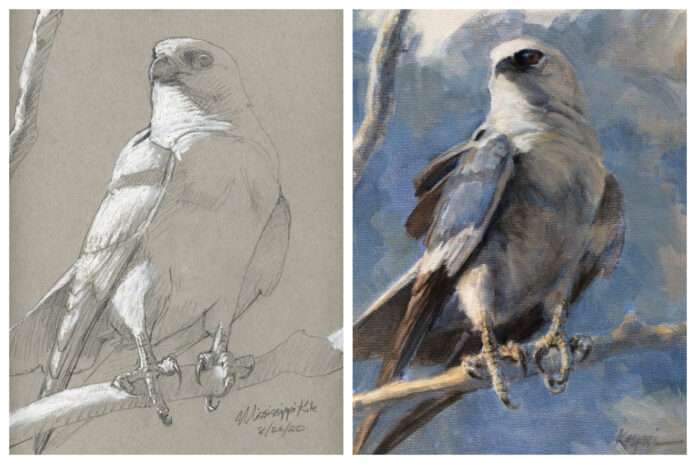As most of you are aware, over the past few years, most small towns around this part of Kansas have become summer homes to magnificent raptors called Mississippi Kites. They arrive in late April to nest and raise young, then in late October they head to South America for the winter. They are marvelous aerialists, and are mesmerizing to watch as they effortlessly glide and navigate the Kansas winds. They feed mostly on insects, and find a real bonanza here when cicadas first appear. Their call is a high-pitched whistle that is very disguisable and common now during mid to late summer.
On Saturday morning two weeks ago, there seemed to be more “kite whistling” going on than usual, and as I walked around the front of our house in preparation for mowing the lawn, I saw why; an very immature Mississippi Kite chick was standing in the lawn along the house. Evidently having tumbled from a hidden nest we were not aware of, the youngster stood there whistling desperately for its parents. I managed to pick it up without getting pecked or clawed and deposited the youngster in the flower bed out-of-the way. A later check found a half-eaten cicada at its feet, telling us its parents were aware of its plight. Later in the day, as the sun became scorching, we moved it again to a corner in front of the house where the sun never directly shines. A small stack of large clay flower pots was laid on their side and turned around and pushed towards the corner, pretty much hiding the little guy from marauding neighborhood cats and a red fox that hunts our end of town, and giving it a place to crawl into at night and out of the weather, which it made good use of. Having no idea of its gender, we named it “Kyle the Kite.” We spoke to the wildlife rehab people at the Hutchinson Zoo, who told us we were handling the situation correctly by not intervening and by allowing the parents to care for it. They also assured us the chick would indeed be able to fledge from there and fly from the ground, but also warned us that kites are notoriously slow learners and it could take 2 weeks or more for the chick to figure things out.
A big picture window in the front of our home faces west, overlooking two big oak trees in the front lawn. Kyle’s temporary “digs” were just around the corner out-of-sight, but we could see its parents constantly coming and going all day, every day, continuously bring snacks. We put a trail camera on one tree and got some nice pictures of an adult bringing food, and of Kyle strutting and exercising its wings. Joyce checked on Kyle most evenings at dusk, always finding it snoozing in its flower pot shelter.
Fast forward to last Thursday morning. Joyce left early to swim at the YMCA, and when I checked on Kyle a little later, it was nowhere to be found. When Joyce got home, she told me Kyle was standing at the edge of the flower garden when she left, looking all proud and grownup, with lots of new feathers and all, and she just had the feeling today was the day Kyle would take to the air and we would never see it again. Later that day, we observed a mature kite coming and going from one tree in the front yard, and sure enough, there sat Kyle peering down from the branches above, now being cared for where he belonged.
We recently lost a good church friend to cancer; Kyle was his name also. Kyle spent his entire life in a wheelchair, in a body with numerous problems, but when our Savior Jesus took him home, just like Kyle the Kite, he flew away in a new body that finally worked. Continue to Explore Kansas Outdoors!
Steve can be contacted by email at stevenrgilliland@gmail.com.





